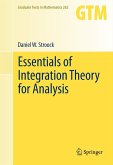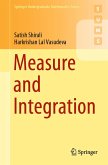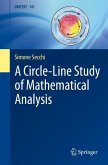When the first edition of this textbook published in 2011, it constituted a substantial revision of the best-selling Birkhäuser title by the same author, A Concise Introduction to the Theory of Integration. Appropriate as a primary text for a one-semester graduate course in integration theory, this GTM is also useful for independent study. A complete solutions manual is available for instructors who adopt the text for their courses. This second edition has been revised as follows: §2.2.5 and §8.3 have been substantially reworked. New topics have been added. As an application of the material about Hermite functions in §7.3.2, the author has added a brief introduction to Schwartz's theory of tempered distributions in §7.3.4. Section §7.4 is entirely new and contains applications, including the Central Limit Theorem, of Fourier analysis to measures. Related to this are subsections §8.2.5 and §8.2.6, where Lévy's Continuity Theorem and Bochner's characterization ofthe Fourier transforms of Borel probability on RN are proven. Subsection 8.1.2 is new and contains a proof of the Hahn Decomposition Theorem. Finally, there are several new exercises, some covering material from the original edition and others based on newly added material.
From the reviews of the first edition:
"The presentation is clear and concise, and detailed proofs are given. ... Each section also contains a long and useful list of exercises. ... The book is certainly well suited to the serious student or researcher in another field who wants to learn the topic. ...the book could be used by lecturers who want to illustrate a standard graduate course in measure theory by interesting examples from other areas of analysis." (Lars Olsen, Mathematical Reviews 2012)
"...It will help the reader to sharpen his/her sensitivity to issues of measure theory, and to renew his/her expertise in integration theory." (Vicentiu D. Radulescu, Zentralblatt MATH, Vol. 1228, 2012)
From the reviews of the first edition:
"The presentation is clear and concise, and detailed proofs are given. ... Each section also contains a long and useful list of exercises. ... The book is certainly well suited to the serious student or researcher in another field who wants to learn the topic. ...the book could be used by lecturers who want to illustrate a standard graduate course in measure theory by interesting examples from other areas of analysis." (Lars Olsen, Mathematical Reviews 2012)
"...It will help the reader to sharpen his/her sensitivity to issues of measure theory, and to renew his/her expertise in integration theory." (Vicentiu D. Radulescu, Zentralblatt MATH, Vol. 1228, 2012)
Dieser Download kann aus rechtlichen Gründen nur mit Rechnungsadresse in A, B, BG, CY, CZ, D, DK, EW, E, FIN, F, GR, HR, H, IRL, I, LT, L, LR, M, NL, PL, P, R, S, SLO, SK ausgeliefert werden.
From the reviews:
"This volume is an appropriate text for a one-semester graduate course in integration theory and is complemented by the addition of several problems related to the new material. ... This volume should become a new relevant reference for integration theory. It will help the reader to sharpen his/her sensitivity to issues of measure theory, and to renew his/hers expertise in integration theory. ... warmly recommends the book with confidence to anyone who is interested in understanding modern integration theory." (Vicentiu D. Radulescu, Zentralblatt MATH, Vol. 1228, 2012)
"This is a book in measure theory at the graduate level. ... The presentation is clear and concise, and detailed proofs are given. ... Each section also contains a long and useful list of exercises. ... The book is certainly well suited to the serious student or researcher in another field who wants to learn the topic. ... the book could be used by lecturers who want to illustrate a standard graduate course in measure theory by interesting examples from other areas of analysis." (Lars Olsen, Mathematical Reviews, Issue 2012 h)
"This volume is an appropriate text for a one-semester graduate course in integration theory and is complemented by the addition of several problems related to the new material. ... This volume should become a new relevant reference for integration theory. It will help the reader to sharpen his/her sensitivity to issues of measure theory, and to renew his/hers expertise in integration theory. ... warmly recommends the book with confidence to anyone who is interested in understanding modern integration theory." (Vicentiu D. Radulescu, Zentralblatt MATH, Vol. 1228, 2012)
"This is a book in measure theory at the graduate level. ... The presentation is clear and concise, and detailed proofs are given. ... Each section also contains a long and useful list of exercises. ... The book is certainly well suited to the serious student or researcher in another field who wants to learn the topic. ... the book could be used by lecturers who want to illustrate a standard graduate course in measure theory by interesting examples from other areas of analysis." (Lars Olsen, Mathematical Reviews, Issue 2012 h)









